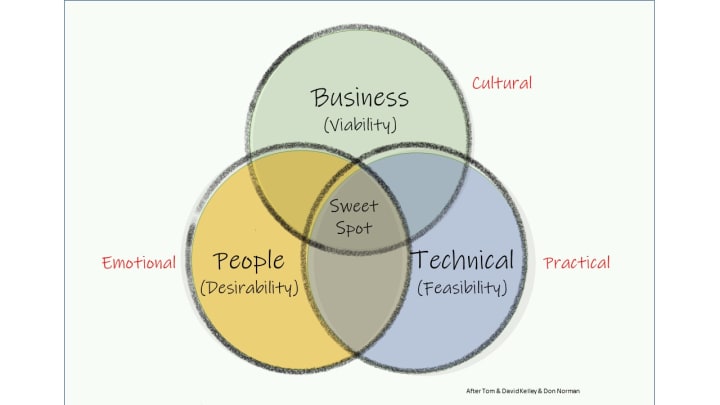Human-Centred Design
The Four Steps of human-focused problem-solving.

The Four Steps of human-focused problem-solving.
In 1994 Proctor and Gamble approached Gianfranco Zaccai, founder of Continuum, a design and branding consultancy, to "Find a better way to clean floors".
The home cleaning market had become stagnant; most people were still cleaning floors by dragging a mop and bucket, full of dirty water, around the floors.
The continuum team began by conducting research with the target customers. They went to people's homes and watched as they cleaned their floors. What they saw changed what they had assumed. Firstly, that most people had already washed their floors in anticipation of the researcher's arrival. Secondly, people hated dragging the bucket of dirty water and mop around as they wiped the floors.
Their observations lead them to understand that home cleaning was value-laden and that their homes' cleanliness reflected how they felt they were viewed by others.
As a result, in 1999, P&G launched the Swiffer, a completely new range of home cleaning products that would enable fast and easy cleaning. Their business model was based on what is called a "razor-and-blade" method. People buy the core product and have to purchase the consumables to go with it. The Swiffer sold more than $100m in the first year and now accounts for $500m in revenue per year.
What interests us here is that this was based on a human-centric approach to product development and design. Design-thinking in this context is a way of identifying human needs and creating solutions for that need.
Human-centred design leads to breakthrough innovations because of its empathy towards understanding and identifying with the target audience. It is intrinsically optimistic in its outlook but requires courage to hold back judgement, move outside the status quo and cliche and step into uncertainty.
Three Factors (IDEO)
According to Tom and David Kelley, good design that is human-centric must satisfy three core factors. Viability, the business aspect. Feasibility, the technical aspect and desirability, the people aspect. All three need to be evident to find the sweet spot of human-centric design. It all starts with people. Human factors offer some of the best opportunities for innovation.

This is very similar to Don Norman's Three Criteria of good design.
A design must be:
· Emotional, we must connect with the object or experience.
· Behavioural, the object or experience must function well and be user-friendly.
· Cultural, the design must make connections and deliver stories that have value.
If we understand why people do what they do, we can design for their needs and desires. This requires empathy because people don't think about how they feel. They don't say what they think and don't do what they say.
Whether it's the design of a product or the creation of a system, the basic design thinking process is the same. It applies to every aspect of the innovation process. Still, it always has to find the sweet spot between feasibility, viability, and desirability, and always based around human needs and desires.
The Four Steps of the Design-Thinking Process
(Tom and David Kelley).
There are four necessary steps (although some break this into more steps).
1. Inspiration
2. Synthesis
3. Ideation and Experimentation
4. Implementation.
Each of these steps is based on; Research, understanding and defining the problem. Observation of behaviour and a Data-gathering phase.

Click here to download Empathy Map
1. Inspiration
There is a myth that inspiration is something we wait for, that happens to us, and we cannot "force" it. This is a mistake and shifts the responsibility from ourselves to something outside ourselves. We need to actively seek experiences that spark innovation.
During this first stage, before ideation, research and raw data collection are the keys. However, to collect data and to research, we need to suspend judgement. It's very easy to observe something and think that that is the right solution.
This limits you in looking at other material which may or may not be useful. Nothing is wasted.
In setting the task for setting up inspiration, it's essential to first decide what problem we are trying to solve. Defining the problem by observation and then reframing is the springboard for inspiration.
Often problems seem to be obvious, but by drilling down more in-depth, we often find that the problem is merely the symptom of another more profound problem. The Toyota system uses a process of continually asking why, like a child, until the root cause of the problem is found. To some extent, we need to remove ourselves from the equation and become superficial, passive observers.
EMPATHIC OBSERVATION.
To observe without judgement, we need to engage our empathy to understand why people do what they do, how they feel, and what triggers their behaviour. We need to understand the context. In this stage, the context is the problem we wish to solve. We cannot overlay our attitude or context onto someone else's behaviour, at least not at this stage.
It's similar to the task, and the actor will take on board when preparing a new role. They have to walk in the shoes of the person who wish to recreate and see the world from their perspective, with the story they want to tell in the back of their minds.
Empathy connects with other people's emotions, motivations, desires and needs. If we see the world from their perspective, we can identify the pain-points and the frustrations that may suggest opportunities for improvement. We must observe first. This may mean moving outside of our comfort zone and getting into unfamiliar environments, and moving away from assumptions and cliché thinking.
This stage will provide the inspiration to be able to move on to the next stage, synthesis.

2. Synthesis.
Once we have gathered all the information in the context of the problem we are trying to solve, we need to make sense of it.
We make sense of information (observations and data) by recognising patterns, themes, meanings and purpose. We can see this in dramatic form when the COVID pandemic analyses data in the context of the problem forms the eventual strategies (although often not effective strategy).
In effect, this stage is about trying to find the underlying "truths" of the behaviour.
BROKEN WINDOWS.
Design-thinkers will often use an empathy map to set out the information to better understand how and why someone behaves as they do. This was put to brilliant effect in what is known as the broken windows effect (see my blog, The Broken window effect). In the clean up of crime in New York in the 1980s, it was observed that one of the underlying reasons for the crime epidemic was a lack of care for the local communities. Once the communities were tidied up, graffiti removed, and a zero-tolerance program introduced, the crime rate fell dramatically.
Tom and David Kelley suggest using an "empathy Map" to analyse behaviour and to be able to convert the research into actionable principles and frameworks.
REFRAMING
It is often the case that the problem itself needs to be reframed in the context of the patterns and themes that arise from the research.
We need to reframe and restate the problem to build a better brief and note how it changes our perceptions of the challenge and suggests different ideas.
There are many different techniques for reframing the challenge; here are a few;
· Reversing the problem.
· Fractionating the problem
· Using metaphor to reframe
· Changing to someone else's point of view.
· Restating the problem in different words.
This phase aims to create a better, broader understanding of the challenge and find the patterns and themes in the inspiration stage.

3. Ideation and Experimentation
We are often impatient to get to this stage where we begin to generate ideas for solving the problem or challenge. Ideas come first but are expanded by experimentation and prototyping.
We should arrive at this stage equipped with all the observations and analysis from the previous stages. And now we can begin to explore new ideas. This involves divergent thinking and should still be kept within the framework of human-centred thinking.
DIVERGENT THINKING.
Again, we need to temporarily suspend judgement and generate ideas. Ideas should be quick and dirty. Quantity is more important at this stage that quality. Even ideas seemingly way out of the reference frame are useful, if only in eliminating one of many possibilities.
This is the expansion of the mind to be playful, silly, confident (which is why we need to suspend judgement)—openness to possibilities.
Divergent thinking is characterised by;
· Metaphor,
· Daydreaming,
· Visualisation,
· Playfulness,
· Humour,
· Non-linear,
· Imagination,
· Generalisation,
· Hunch,
· Intuition,
· Unconscious (gut) reaction.
QUOTAS
Edward de Bono suggests setting a quota for the number of ideas generated. This should be challenging. The reason to do this is that it is very easy to arrive at a promising idea and then stop generating further ideas. By setting a quota beyond what we might consider reasonable, we continue to create more ideas. The obvious idea may turn out to be the idea taken forward, but the additional ideas will help expand understanding of the challenge. They will eliminate ideas that may not be practical.
EXPERIMENT AND PROTOTYPE.
It's crucial to try out ideas, and typically, we should do this by creating models, prototypes and experiments to test the ideas and generate newer, possibly better, solutions.
"I made 5,127 prototypes of my vacuum before I got it right. There were 5,126 failures. But I learned from each one. That's how I came up with a solution. So I don't mind failure…The key to success is failure… Success is made of 99 per cent failure."
James Dyson
Models and prototypes need to also be quick and dirty at first. They need to be able to adapt, iterate and pivot.
Experimentation need not be just for physical products; they can just as easily be strategies, flows, acting out scenarios or concepts. The secret to this stage is to iterate, test and try.

4. Implementation.
Implementation can mean moving from divergent thinking to convergent thinking, making plans to bring a product or solution to fruition.
Having generated many ideas and refined them to a shortlist, then tested, prototyped and experimented with them, there now need to be a roadmap to its targeting market. This will depend on what elements are included and which are excluded. This will involve further analysis. This is also a learning phase and may have many iterations.
It's essential to remain agile and flexible during this phase so that new information can quickly be reviewed, iterated and refined.
Design Thinking is, simply put, a way of finding Human needs and creating solutions. It is a methodology that relies on the human ability to recognise patterns of behaviour and construct ideas that are emotionally meaningful and behaviourally functional. I would add that there is also a context of culture and story that must also be evident if a solution is effective and successful.
It is important to bear in mind that design thinking uses rational, analytical and convergent thinking and irrational, inductive and divergent thinking. Both are equally important and desirable in problem and challenge solving. It is equally important not to snap into a "problem-solving" mode of thinking. We need to be open and have what Carol Dweck calls a "Growth Mindset". Don't rush into judgement.
Design thinking changes something from one state to another; it is transformational. There are many possible (and sometimes seemingly impossible) solutions to problems and challenges; we need, in the initial stages, to be broad, not deep. In the latter stages, we need to be deep, not wide.
Human-centred design thinking is always about observation, understanding, open-mindedness and the ability to see patterns and themes, eventually converting into human-centred solutions.







Comments
There are no comments for this story
Be the first to respond and start the conversation.